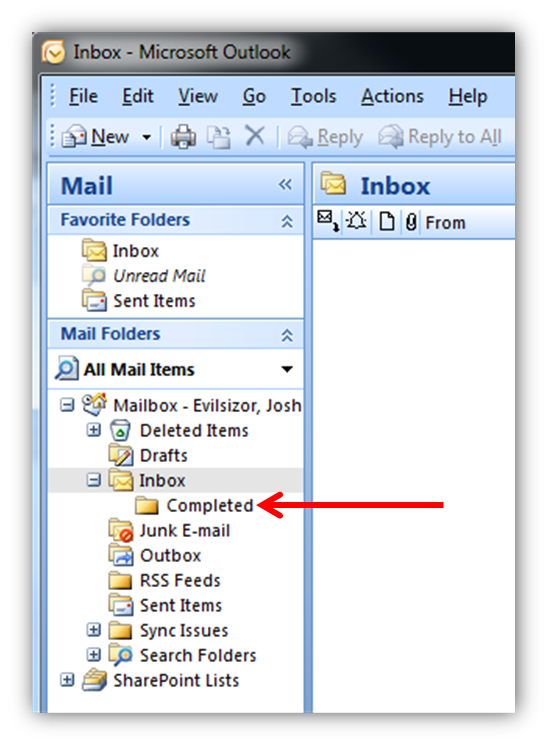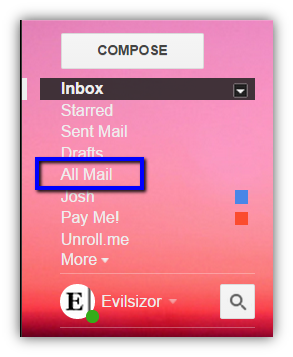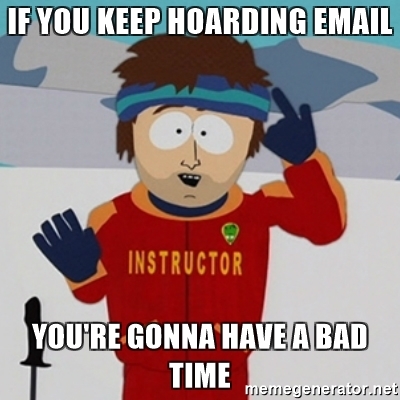If you’re interested in reaching inbox zero using simple, sustainable processes, and you want to learn the most successful strategy from the very beginning, this is where you start.
Whether your inbox currently has 50, 100, or 1,000 emails, functionally it works the same as everyone else’s.
Every email inbox is the same in that they all have:
An email in folder (i.e. inbox)
An email sent folder (or label)
So what is the most important element that separates successful inbox zero-ers from everyone else?
An email completed folder
No matter what methodology you might subscribe to (GTD, inbox zero, etc.) the completed folder is the foundational building block necessary to reach zero emails. What this folder looks like, how it functions, and what it is named varies depending on each user’s preferred email platform.
If you’re using Outlook, it’s simply a folder.
If you’re using using Gmail, it’s the All Mail archive (and perhaps a label).
If you’re using some other service, it might be something else. They key is, moving the email out of your inbox to this location — every time — once the information or action associated with the email has been captured or completed.
So in summary:
- Check email
- Capture or complete email task
- Close-Out email by moving it to a completed folder
The lack of a reliable capture system leads to email hoarding and is generally why most people will never attain inbox zero.
The reason people fail to follow all three steps — every time — is because they lack a reliable, fail-safe system that allows them to completely capture information or complete tasks associated with the emails they receive. Since they are unable to completely capture/complete email tasks, they are then unable to discard or remove those emails from their inbox and they begin hoarding.
A few simple reasons people hoard emails in their inbox:
- Procrastination. The email contains a small or large task that the hoarder continues to put off until later.
- Awaiting Follow-up. Most likely, this email was a request from someone. Because the hoarder didn’t have some or all of the required information to answer, they forwarded it to someone else for additional information. Keeping the original email in their inbox is a daily reminder that they are awaiting follow-up from that person.
- Information. The hoarder feels that they might need the information in the email sometime in the near or not-too-distant future.
- Other. Insert the one million other reasons hoarders do not do what is most efficient – get rid of the email!
Email hoarding is guaranteed to prevent inbox zero 100% of time. I know this to be true because I used to do every single one of the things listed above. I even used to brag about how well I used my inbox as a to-do list (although inefficient, I was good at it). Regardless, those were very dark times.
To illustrate the futility: How many times have you created a to-do list right when you first got to work, and then left work with items unfinished? Probably a better question would be, when have you ever completed every item on your to-do list before leaving work?
Rarely or never is exactly the truthful answer. This is why you’ll never hear anyone talking about to-do list zero — it is unattainable. There will always be more to do.
So if you’re an email hoarder and you understand how to-do lists only grow, and never shrink, why would you ever use your inbox as a never-ending hub for persistent follow-up reminders, random data center facts, and an ever growing list of things to do for other people?
The detailed physical mechanics of reaching inbox zero
Moving completed emails in Outlook is done by left-clicking and dragging emails from the Inbox to the Completed folder.
This is done in Gmail by archiving emails. 
Those are the physical mechanics, and obviously simple enough for anyone to master.
The part that’s actually difficult about putting an end to email hoarding is understanding exactly what must be done, in any scenario, in order to squeeze the last drop of importance from an email and truly remove it (from your inbox and your hippocampus). I’ll explore the numerous ways to capture and complete email tasks in another post.
In summary
The only way to achieve less email (and ultimately zero email) is to eliminate email hoarding. The only way to eliminate email hoarding is by completing the following steps, every day:
- Check email
- Complete/capture email
- Close-Out email
In case you’re wondering – yes. This article just broke down in great detail, the last step in the Evilsizor inbox zero methodology; closing out email. If you’re interested in steps 1-2 please stay tuned (if you’re reading this in real time) or just navigate to the next post (if you’re reading this any time period greater than a few weeks from today).
My challenge to you is to take the first couple steps. If you’re a Gmail user, learn how to use the archive function. If you’re an Outlook user, add a completed folder (or maybe get rid of the too many folders you already have but fail to use). Then, the next time you receive an email, render it inert and close it out.
That’s all there is to it.
Also published on Medium.
